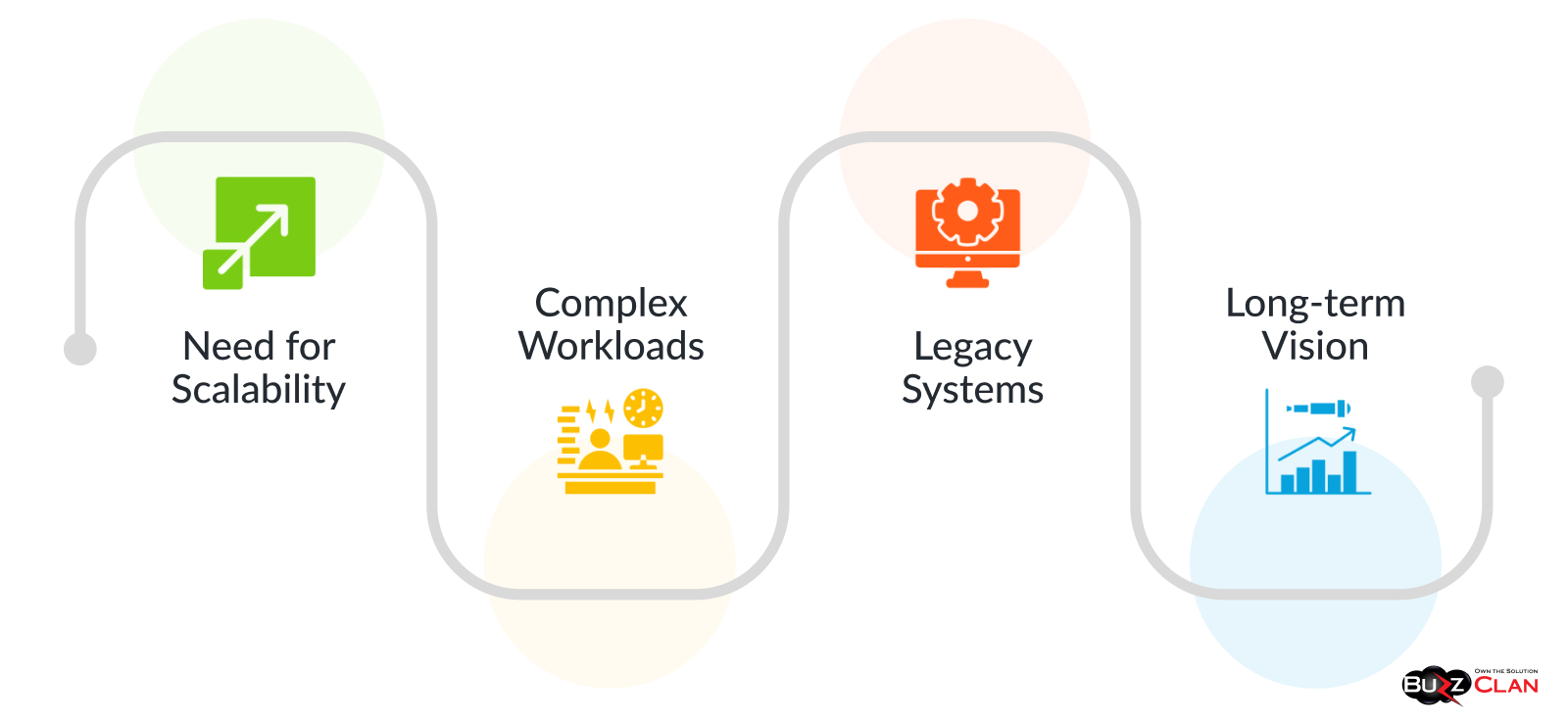Mastering Cloud Migration: The Complete Guide to Refactoring Strategies
Gururaj Singh
Feb 8, 2024
Introduction
In the ever-evolving cloud technology landscape, one term you'll likely come across is "refactoring." While this term originates from software development, which refers to changing the code structure without altering its functionality, it takes on a broader yet more focused meaning in the cloud migration context. Refactoring in cloud migration is modifying or re-architecting an application to take advantage of cloud-native features and capabilities without fundamentally changing the core application's purpose.
So, why is this essential? Refactoring can drastically improve an application’s performance, scalability, and cost-effectiveness. This makes it a vital topic not just for tech geeks and software engineers but also for business leaders, CTOs, and anyone considering or migrating to the cloud.
What's in store for you in this blog? We will not only break down the nuts and bolts of refactoring but also delve into its business case, offering a step-by-step guide on how to approach it. And if you're the kind who appreciates real-world wisdom, stay tuned for actual case studies and insights from industry experts that will equip you to make informed decisions in your cloud migration journey.
The Rise of Cloud Migration
Cloud migration isn't just a buzzword; it’s fast becoming the linchpin of digital transformation strategies for businesses of all sizes. According to a report by IDC, over 90% of enterprises worldwide will rely on a mix of on-premises, dedicated private clouds, multiple public clouds, and legacy platforms to meet their infrastructure needs. That's a lot of clouds on the horizon!
Refactoring is emerging as a more relevant strategy in this rush to the cloud than ever before. With the cloud landscape becoming increasingly sophisticated, businesses are looking beyond mere "lift-and-shift" tactics. They're seeking to maximize the potential of the cloud's native capabilities, be it in terms of scalability, performance, or long-term cost benefits. That’s where refactoring shines. It enables companies to optimally adapt their applications to the cloud environment, thereby leveraging the full power of cloud computing.
What is Refactoring in Cloud Migration?
In software development, refactoring is akin to giving your code a "spa day." It involves restructuring existing computer code—changing its form but not its function—to improve its readability, efficiency, or maintainability. Imagine reorganizing your closet: the clothes remain the same but are now easier to find and better arranged. In coding terms, you modify the internal structure of the software without altering its external behavior, making it easier for developers to work on it, troubleshoot it, and update it in the future.
Now, let's pivot to cloud migration. In this context, refactoring takes on a more ambitious role. It's not merely about tweaking code for tidiness; it’s about re-architecting or modifying an application to leverage cloud-native features fully. The goal? Tap into the cloud ecosystem's bells and whistles to boost performance and enable scalability, like serverless computing or managed services. Cloud refactoring is like moving from a regular home to a smart home, where the aesthetics, functionalities, and efficiencies are upgraded. In the realm of cloud migration, the '7 Rs of cloud migration' can help businesses grow and optimize in a better way.
Why Refactoring? The Business Case
At first glance, refactoring seems like a techie's pet project: complex, time-consuming, and esoteric. But here's the kicker: a robust business case exists. First and foremost, refactoring can enhance the performance of your applications. By leveraging cloud-native services and architectures, your applications can achieve lower latency and faster load times, directly improving user experience and potentially increasing revenue.
Scalability is another massive plus. Traditional on-premises solutions often require significant investment in hardware and personnel to scale up. In contrast, cloud-native applications designed through refactoring can easily adjust to growing user demand, thanks to the elasticity of the cloud. You can instantly scale up or down based on real-time needs, reducing operational complexity and cost.
Speaking of costs, let's pay attention to the long-term cost-effectiveness. While refactoring requires an initial investment of time and resources, it pays off by significantly reducing operational overhead. Imagine swapping out all your traditional light bulbs for energy-efficient LEDs; the upfront cost might be higher, but the long-term savings are undeniable.
When to Choose Refactoring in Cloud Migration

With all these advantages, you might be tempted to think that refactoring is the go-to strategy for any cloud migration. However, it's not a one-size-fits-all solution. Here are some instances when you might want to consider refactoring seriously:
- Legacy Systems: If you're dealing with an outdated application with performance issues, refactoring can bring new life by modernizing its architecture.
- Need for Scalability: For businesses eyeing rapid growth or dealing with fluctuating usage patterns, refactoring allows you to build elasticity into your applications, making it easier to scale up or down as needed.
- Complex Workloads: When your applications have complex workloads that can benefit from specialized cloud services like AI or data analytics, refactoring can help you integrate these services seamlessly.
- Long-term Vision: If you're looking beyond just a quick migration and aim for a future-proof infrastructure, refactoring offers a path to make the most out of cloud-native features for years.
How to Approach Refactoring in Cloud Migration: A Step-By-Step Guide
Embarking on a refactoring journey is much like planning a road trip—you need a detailed map, and a few pit stops for a successful journey. Here's how to navigate the process:
Initial Assessment:
- Start by analyzing your existing applications and architecture.
- Identify what needs refactoring and what doesn't.
- Tip: Use automated assessment tools to speed up this phase.
Set Objectives:
- Define your goals clearly. Are you looking for better performance, scalability, or both?
- Tip: Align your objectives with business outcomes for stakeholder buy-in.
Choose the Right Tools:
- Depending on your needs, pick the cloud services and tools that align with your refactoring goals.
- Tip: Consult with cloud service providers or experts for customized solutions.
Develop a Blueprint:
- Draft a detailed plan, including timelines, resources, and potential challenges.
- Tip: Use project management software to keep everyone in the loop.
Pilot Testing:
- Before going full-scale, test the refactored elements in a controlled environment.
- Tip: Pay attention to performance metrics and make adjustments as necessary.
Full-Scale Execution:
- Roll out the refactored application or components, closely monitoring any issues.
- Tip: Prepare a rollback plan in case things don’t go as expected.
Review and Iterate:
- Once the refactored application is live, conduct a review to ensure it meets the objectives.
- Tip: Use this opportunity for continuous improvement, applying lessons learned to future projects.
Real-World Examples of Refactoring in Cloud Migration

Real-life examples are the seasoning on the refactoring entrée—providing that extra layer of flavor that helps you truly appreciate its essence. Let's look at some companies that successfully employed refactoring during their cloud migration:
- Netflix: A pioneer in cloud adoption, Netflix opted for significant refactoring to leverage cloud-native features fully. This enabled them to achieve unparalleled scalability, effortlessly serving millions of concurrent users across the globe.
- GE Aviation: This company undertook a massive refactoring project when migrating its Asset Transfer System to the cloud. The goal was to optimize performance and implement serverless architecture. The results were staggering—a 90% reduction in operational overhead and improved system efficiency.
- Etsy: Famed for its handmade and vintage goods, Etsy decided that refactoring was the way to go for its complex e-commerce platform. They achieved greater flexibility and cost-efficiency by embracing cloud-native services and breaking monolithic structures into microservices.
These examples offer a unique take away—scalability like Netflix, operational efficiency like GE Aviation, or flexibility and cost savings like Etsy. It's proof that refactoring, when executed well, is a boon for any cloud migration strategy.
Common Pitfalls of Refactoring and How to Avoid Them

Refactoring isn't without its challenges; it’s like trying to remodel your house while you're still living in it—you're bound to encounter some roadblocks. Here are some common pitfalls and how to sidestep them:
Underestimating Complexity:
- Refactoring can be more complicated than it appears, and failing to understand the intricacies can lead to delays and cost overruns.
- Tip: Do a thorough initial assessment, and don't shy away from consulting experts.
Lack of Stakeholder Buy-in:
- If upper management or team members are not on board, your refactoring project could face internal obstacles.
- Tip: Make a compelling business case, aligning refactoring goals with overall business objectives.
Poor Communication:
- A lack of clarity among team members can result in errors and delays.
- Tip: Maintain open communication channels and use project management tools to keep everyone updated.
Skipping Testing:
- Rushing to deploy without adequate testing can result in performance issues or even downtime.
- Tip: Always schedule thorough pilot testing and prepare a rollback plan.
Expert Opinions on Refactoring
When it comes to refactoring, don't just take our word for it. Industry experts also vouch for its merits and best practices:
- "Refactoring is not just an IT chore; it's a business imperative. The payoffs in performance and scalability can be significant," says Jane Smith, CTO of Cloudify Inc.
- "The key to successful refactoring is twofold: rigorous testing and ongoing communication between IT and business stakeholders," advises Michael Brown, a renowned cloud architect and author of 'Cloud Migration Mastery.'
- "In the rapidly evolving cloud landscape, refactoring is your ticket to staying relevant. It allows you to leverage the latest cloud services to gain a competitive edge," notes Dr. Emily Chen, a cloud computing researcher and consultant.
These expert affirmations serve as an exclamation mark on the importance and best practices of refactoring in cloud migration. They corroborate the notion that refactoring isn't just a tech exercise but a strategic move that aligns with broader business goals.
Conclusion
In the fast-paced realm of cloud computing, staying ahead means continuously adapting and improving. Refactoring is more than a techie term tossed around in boardrooms; it's a pivotal strategy for businesses serious about leveraging the full power of the cloud. The benefits are too compelling to ignore, from enhancing performance to improving scalability and cost-efficiency.
Whether a startup eyeing rapid expansion or an established enterprise looking to modernize legacy systems, refactoring can be the secret to your cloud migration success. But remember, it’s not a one-size-fits-all. Assess your needs, consult the experts, and tread carefully to avoid common pitfalls.

Get In Touch
Follow Us
Table of Contents
- Introduction
- The Rise of Cloud Migration
- What is Refactoring in Cloud Migration?
- Why Refactoring? The Business Case
- When to Choose Refactoring in Cloud Migration
- How to Approach Refactoring in Cloud Migration: A Step-By-Step Guide
- Real-World Examples of Refactoring in Cloud Migration
- Common Pitfalls of Refactoring and How to Avoid Them
- Expert Opinions on Refactoring
- Conclusion
- Get In Touch
